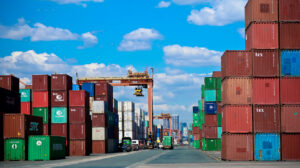
July trade deficit narrows to two-month low

By Heather Caitlin P. Mañago
The Philippines’ trade deficit in goods narrowed to its two-month low in July, as exports expanded by double digits while imports eased, the Philippine Statistics Authority (PSA) reported on Friday.
Preliminary data from the PSA showed the country’s trade-in-goods balance — the difference between exports and imports — reached a deficit of $4.05 billion in July, 17% smaller than the $4.88-billion deficit in July last year.
Month on month, the trade gap slimmed from the revised $4.40 billion in June.
July saw the narrowest trade deficit since the $3.63-billion gap in May 2025.
For the first seven months, the trade deficit narrowed to $28.46 billion, 4.9% lower from the $29.93-billion deficit a year ago.
The country’s trade balance has been in deficit for over a decade or since the $64.95-million surplus recorded in May 2015.
In the January-to-July period, exports increased by 13.9% to $48.62 billion, while imports rose by 6.1% to $77.09 billion.
The Development Budget Coordination Committee (DBCC) projects a 2% contraction and 3.5% growth in exports and imports, respectively, this year.
EXPORTS GROW
Total outbound sales of Philippine-made goods grew by 17.3% year on year in July to $7.34 billion, higher than the 0.1% expansion a year earlier. However, this pace was slower than the revised 26.9% growth in June.
It was the slowest pace for exports in two months or since the 15.5% growth posted in May.
By value, July logged the largest haul in exports since the $7.75 billion in October 2022.
“The faster growth of exports relative to imports contributed to the narrowing of the country’s trade deficit,” Cid L. Terosa, senior economist at the University of Asia and the Pacific, said in an e-mail.
He attributed the increase in exports to the rise in agro-based and mineral products.
Exports of agro-based products went up by 20.4% year on year to $615.59 million in July.
Mineral products, which make up 12.1% of total export, grew by 62% annually to $887.18 million for the month.
Mr. Terosa attributed the increased demand for these products to “stronger than expected economic growth in major economies, seasonal demand in export markets, and a weaker peso in July 2025 relative to June 2025.”
For Executive Vice-President and Chief Operating Officer of Philippine Exporters Confederation, Inc. (Philexport) Senen M. Perlada attributed the trade deficit narrowing to “the surge in exports (which was) still led by electronic products (mainly semiconductors), mineral products (including gold).”
The country’s exports of electronic products, which accounted for 53.5% of total export, remained the top commodity rising by 20.7% to $3.92 billion.
Outbound sales of other mineral products soared more than twofolds to $522.39 million, while other manufactured goods fell by 13.9% to $395.77 million.
Mr. Perlada said that stronger global demand for electronics and a recovering semiconductor sector is boosting Philippine exports.
“A broad semiconductor, AI (artificial intelligence), and datacenter led recovery in chip demand in 2025 has apparently boosted orders for electronics and components across Asia, which has continued to lift export volumes and values,” he said in an e-mail.
“The delay of Trump’s imposition of reciprocal tariffs to Aug. 7 provided breathing room for exporters in many countries, including the Philippines, to export more to their markets in major economies before the tariffs were imposed,” Mr. Terosa said.
Similarly, for Mr. Perlada, the boost in exports is due to frontloading ahead of the tariff issue in the United States (US), the top export market.
George T. Barcelon, chairman of Philippine Chamber of Commerce and Industry (PCCI), said in a phone interview that “since the uncertainty of how much tariff will be imposed on our exports, on our side, a lot of exporters are having this ‘wait-and-see’ attitude.”
In July, the US was the top destination for Philippine-made goods at $1.16 billion with 15.8% share of total exports. It was closely followed by Hong Kong ($1.12 billion or 15.2% share), Japan ($996.44 million or 13.6% share), and China ($832.57 million or 11.3% share).
IMPORTS SLOWDOWN
Meanwhile, the country’s merchandise imports slowed by 2.3% year on year to $11.38 billion in July, as well as the 15.7% increase in June.
This was the weakest pace in two months or since the 1.1% drop in May.
Likewise, the import bill that month was the smallest amount in two months or since the $10.95 billion in May.
Mr. Perlada said “imports grew more slowly and in recent months were held back by muted oil and commodity import needs and possibly shifting shipping patterns.”
He added that these movements represent a combination of the ongoing global demand for electronics and semiconductors, along with the resulting impact of commodity price fluctuations — especially in gold and other minerals.
By commodity group, electronic products, which accounts for 24.6% of total imports, went up by 10.2% to $2.80 billion in July.
On the other hand, mineral fuels, lubricants and related materials declined by 7.8% with $1.32 billion. This was followed by transport equipment with a 2.8% drop to $1 billion.
China was the top source of imports in July with $3.40 billion (29.9% share). South Korea followed with $1.01 billion (8.9% share) and Indonesia with $898.40 million (7.9% share).
OUTLOOK
Moving forward, Mr. Terosa said that risks that should be anticipated are geopolitical tensions and trade tensions following the implementation of Trump’s reciprocal tariffs.
“Renewed tariff actions such as those from China and India, among others, may make their impact towards the end of the year. These could quickly change cost patterns and trade flows,” Mr. Perlada said.
Another risk he flagged is the softening in demand of semiconductors, which may slow Philippine export momentum.
“Looking ahead, upcoming trade reports will likely shed more light on the impact of US tariffs on trade, particularly as the higher 19% levy began to take effect earlier this [August],” Chinabank Research said in a note.
It added that rising demand from other export markets may cushion the impact of weaker US demand when front-loading wanes and higher tariffs bite.
“However, the sector could face challenges if US President Trump follows through with his threat of a 100% tariff on semiconductors. Currently, most of the Philippines’ chip exports are exempt from higher US reciprocal tariffs,” it said.
Trade Undersecretar
Allan B. Gepty said on Thursday that the government is seeking US tariff exemptions for exports of agricultural commodities, electronics, vehicle tires, bags and aircraft parts.
Mr. Trump had earlier said he plans to announce higher tariffs on imports of semiconductors, but companies that plan to build manufacturing facilities in the US would be exempted. The US has yet to set new global tariffs for semiconductors and pharmaceuticals



